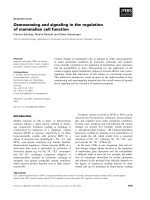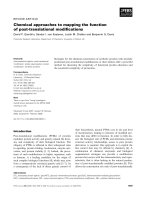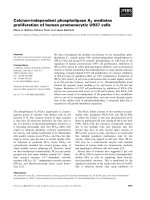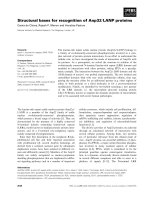Tài liệu Báo cáo khoa học: "Hypertext Authoring for Linking Relevant Segments of Related Instruction Manuals" pptx
Bạn đang xem bản rút gọn của tài liệu. Xem và tải ngay bản đầy đủ của tài liệu tại đây (455.14 KB, 5 trang )
Hypertext Authoring for Linking Relevant Segments of
Related Instruction Manuals
Hiroshi Nakagawa and Tatsunori Mori and Nobuyuki Omori and Jun Okamura
Department of Computer and Electronic Engineering, Yokohama National University
Tokiwadai 79-5, Hodogaya, Yokohama, 240-8501, JAPAN
E- mail: nakagawa@ n aklab, dnj. ynu. ac.j p, { mori, ohmori ,j un } @forest. dnj. ynu. ac.j p
Abstract
Recently manuals of industrial products become
large and often consist of separated volumes. In
reading such individual but related manuals, we
must consider the relation among segments, which
contain explanations of sequences of operation. In
this paper, we propose methods for linking relevant
segments in hypertext authoring of a set of related
manuals. Our method is based on the similarity
calculation between two segments. Our experimen-
tal results show that the proposed method improves
both recall and precision comparing with the con-
ventional
tf. idf
based method.
1 Introduction
In reading traditional paper based manuals, we
should use their indices and table of contents in or-
der to know where the contents we want to know are
written. In fact, it is not an easy task especially for
novices. Recent years, electronic manuals in a form
of hypertext like
Help
of
Microsoft Windows
became
widely used. Unfortunately it is very expensive to
make a hypertext manual by hand especially in case
of a large volume of manual which consists of sev-
eral separated volumes. In a case of such a large
manual, the same topic appears at several places in
different volumes. One of them is an introductory
explanation for a novice. Another is a precise ex-
planation for an advanced user. It is very useful to
jump from one of them to another of them directly
by just clicking a button of mouse in reading a man-
ual text on a browser like
NetScape.
This type of
access is realized by linking them in hypertext for-
mat by hypertext authoring.
Automatic hypertext authoring has been focused
on in these years, and much work has been done. For
instance, Basili et al. (1994) use document struc-
tures and semantic information by means of natural
language processing technique to set hyperlinks on
plain texts.
The essential point in the research of automatic
hypertext authoring is the way to find semantically
relevant parts where each part is characterized by
a number of key words. Actually it is very similar
with information retrieval, IR henceforth, especially
with the so called passage retrieval (Salton et al.,
1993). J.Green (1996) does hypertext authoring of
newspaper articles by word's lexical chains which are
calculated using WordNet. Kurohashi et al. (1992)
made a hypertext dictionary of the field of infor-
mation science. They use linguistic patterns that
are used for definition of terminology as well as the-
saurus based on words' similarity. Furner-Hines and
Willett (1994) experimentally evaluate and compare
the performance of several human hyper linkers. In
general, however, we have not yet paid enough at-
tention to a full-automatic hyper linker system, that
is what we pursue in this paper.
The new ideas in our system are the following
points:
1. Our target is a multi-volume manual that de-
scribes the same hardware or software but is dif-
ferent in their granularity of descriptions from
volume to volume.
2. In our system, hyper links are set not between
an anchor word and a certain part of text but
between two segments, where a segment is a
smallest formal unit in document, like a sub-
subsection of ~TEX if no smaller units like
subsubsubsection are used.
3. We find pairs of relevant segments over two
volumes, for instance, between an introductory
manual for novices and a reference manual for
advanced level users about the same software or
hardware.
4. We use not only
tf.idf
based vector space model
but also words' co-occurrence information to
measure the similarity between segments.
2 Similarity Calculation
We need to calculate a semantic similarity between
two segments in order to decide whether two of them
are linked, automatically. The most well known
method to calculate similarity in IR is a vector space
model based on
tf • idf
value. As for
idf,
namely
inverse document frequency, we adopt a segment in-
929
stead of document in the definition of
idf.
The def-
inition of
idf
in our system is the following.
of segments in the manual
idf(t)
= log ~ of segments in which t occurs + 1
Then a segment is described as a vector in a vector
space. Each dimension of the vector space consists
of each term used in the manual. A vector's value
of each dimension corresponding to the term t is
its
tf • idf
value. The similarity of two segments is
a cosine
of two vectors corresponding to these two
segments respectively. Actually the
cosine
measure
similarity based on
tf. idf
is a baseline in evaluation
of similarity measures we propose in the rest of this
section.
As the first expansion of definition of
tf • idf,
we
use case information of each noun. In Japanese, case
information is easily identified by the case particle
like
ga(
nominal marker ), o( accusative marker ),
hi( dative marker ) etc. which are attached just af-
ter a noun. As the second expansion, we use not only
nouns (+ case information) but also verbs because
verbs give important information about an action a
user does in operating a system. As the third expan-
sion, we use co-occurrence information of nouns and
verbs in a sentence because combination of nouns
and a verb gives us an outline of what the sentence
describes. The problem at this moment is the way
to reflect co-occurrence information in
tf. idf
based
vector space model. We investigate two methods for
this, namely,
1. Dimension expansion of vector space, and
2. Modification of
tf
value within a segment.
In the following, we describe the detail of these two
methods.
2.1 Dimension Expansion
This method is adding extra-dimensions into the
vector space in order to express co-occurrence in-
formation. It is described more precisely as the fol-
lowing procedure.
1. Extracting a case information
(case particle
in
Japanese) from each noun phrase. Extracting a
verb from a clause.
2. Suppose be there n noun phrases with a case
particle in a clause. Enumerating every combi-
nation of 1 to n noun phrases with case particle.
12
Then we have E nCk combinations.
6=1
3. Calculating
tf • idf
for every combination with
the corresponding verb. And using them as new
extra dimensions of the original vector space.
For example, suppose a sentence "An end user
learns the programming language." Then in ad-
dition to dimensions corresponding to every noun
phrase like "end user", we introduce the new di-
mensions corresponding to co-occurrence informa-
tion such as:
• (VERB, learn) (NOMNINAL end user) (AC-
CUSATIVE programming language)
• (VERB, learn) (NOMNINAL end user)
• (VERB, learn) (ACCUSATIVE programming
language)
We calculate
tf. idf
of each of these combinations
that is a value of vector corresponding to each of
these combinations. The similarity calculation based
on
cosine
measure is done on this expanded vector
space.
2.2 Modification of
tf
value
Another method we propose for reflecting co-
occurrence information to similarity is modification
of
tf
value within a segment. (Takaki and Kitani,
1996) reports that co-occurrence of word pairs con-
tributes to the IR performance for Japanese news
paper articles.
In our method, we modify
tf
of pairs of co-
occurred words that occur in both of two segments,
say
dA
and dB, in the following way. Suppose that a
term tk, namely noun or verb, occurs f times in the
segment
da.
Then the modified
tf'(da, tk)
is defined
as the following formula.
tf'(dA, tk) = t f(da, tk)
1
+ Z E cw(dA,tk,p, tc)
teETc(tk,da,dB)P =1
1
"}- E E Cw'(da,tk,p, tc)
tcGTc( tk ,dA,dB ) P =1
where
cw
and
cw'
are scores of importance for co-
occurrence of words, tk and t~. Intuitively,
cw
and
cw'
are counter parts of
tf. idf
for co-occurrence of
words and co-occurrence of (noun case-information),
respectively,
cw
is defined by the following formula.
cw(dA, tk, p, to)
a(dA,~k,p,t~) X ~(tk,t~)
X 7(tk,/c) X C
M(dA)
where c~(da, tk, p, to) is a function expressing how
near tkand t~ occur, p denotes that pth tk's occur-
rence in the segment
dA,
and fl(tk,t¢) is a normal-
ized frequency of co-occurrence of ¢~ and ¢~. Each
of them is defined as follows.
a(dA, tk, p, t~) = d(dA, tk, p) - dist(dA, tk, p, t~)
d(dA, tk, p)
930
rtf(t~,t¢)
~(tk,t~)- atf(tk)
where the function
dist(da, tk,p, to)
is a distance
between pth t~ within
da
and
tc
counted by word.
d(da,tk,p)
shows the threshold of distance within
which two words are regarded as a co-occurrence.
Since, in our system, we only focus on co-occurrences
within a sentence,
a(da,tk,p,t~)
is calculated for
pairs of word occurrences within a sentence. As a
result,
d(dA,tk,p)
is a number of words in a sen-
tence we focus on.
atf(tk)
is a total number of
tk's occurrences within the manual we deal with.
rtf(tk, t~)
is a total number of co-occurrences of tk
and tc within a sentence. 7(t~, to) is an inverse doc-
ument frequency ( in this case "inverse segment fre-
quency") of te which co-occurs with tk, and defined
as follows.
N
7(tk, fc) =
lOg( d-~c ) )
where N is a number of segments in a manual,
and
dr(to)
is a number segments in which tc occurs
with tk.
M(da)
is a length of segment
da
counted in mor-
phological unit, and used to normalize
cw. C
is a
weight parameter for
cw.
Actually we adopt the
value of C which optimizes 1 lpoint precision as de-
scribed later.
The other modification factor
cw'
is defined in al-
most the same way as
cw
is. The difference between
cw
and
cw'
is the following,
cw
is calculated for
each noun. On the other hand,
cw'
is calculated for
each combination of noun and its case information.
Therefore,
cw I
is calculated for each ( noun, case )
like (user, NOMINAL). In other words, in calcula-
tion of
cw',
only when ( noun-l, case-1 ) and ( noun-
2, case-2 ), like (user NOMINAL) and (program AC-
CUSATIVE), occur within the same sentence, they
are regarded as a co-occurrence.
Now we have defined
cw
and
cw'.
Then back to
the formula which defines
tf'.
In the definition of
tf', Tc(tk, dA, dB)
is a set of word which occur in
both of
dA
and dB. Therefore
cws
and
cw's
are
summed up for all occurrences of tk in
dA.
Namely
we add up all
cws
and
cw%
whose tc is included in
T~(tk, dA, dn)
to calculate
tf'.
3
Implementation and Experimental
Results
Our system has the following inputs and outputs.
Input is an electronic manual text which can be
written in plain text,I~TEXor HTML)
Output is a hypertext in HTML format.
Electronic Manuals manual A manual B
WO~as-~red2o~S
~ ~Ke),word~xtra~ =
"4 tf
i~[cutatlon
,
Slrnllafl~/Calculation
based
on Vector Space
Mode
1
[
Hypeaext Unk Genarator
I OUTPUT
HYPERTEXT
~ orphological
Ana~s
System
manual A manual B
Figure h Overview of our hypertext generator
We need a browser like
NelScape
that can display
a text written in HTML. Our system consists of four
sub-systems shown in Figure 1.
Keyword Extraction Sub-System In this sub-
system, a morphological analyzer segments out
the input text, and extract all nouns and verbs
that are to be keywords. We use Chasen 1.04b
(Matsumoto et al., 1996) as a morphological
analyzer for Japanese texts. Noun and Case-
information pairs are also made in this sub-
system. If you use the dimension expansion de-
scribed in 2.1, you introduce new dimensions
here.
tf- idf Calculation Sub-System
This sub-system calculates
tf • idf
of extracted
keywords by Keyword Extraction Sub-System.
Similarity Calculation Sub-System This sub-
system calculates the similarity that is repre-
sented by
cosine
of every pair of segments based
on
tf • idf
values calculated above. If you use
modifications of
tf
values described in 2.2, you
calculated modified
t f,
namely
tf'
in this sub-
system.
Hypertext Generator This sub-system trans-
lates the given input text into a hypertext in
which pairs of segments having high similarity,
say high
cosine
value, are linked. The similarity
of those pairs are associated with their links for
user friendly display described in the following
We show an example of display on a browser in
Figure 2. The display screen is divided into four
parts. The upper left and upper right parts show
a distinct part of manual text respectively. In the
lower left (right) part, the title of segments that
are relevant to the segment displayed on the upper
left (right) part are displayed in descending order of
931
1
FS-Ze FAir V~w Go Booka~pa 0pt~orm
D~ZU3ry WJz~:l~ H~p
.__v_J- -2_J I
m
Location: IIhtt~ ://~. forest, dr,,j. Ynu. ,etc. 5p/+SuxVjum_ch~frame+ htqL~
~hat" s ~1 ~t'~
~?1
Ikstlnati°nsl Net Search I l~opl¢l Soft,zre I
E JUMAN ~
ChaSen 1.0 'r'~.6r~
l- J b~R~L~ t~ ~ =k
~ t~.ANSt
ttl L,~.
-t-
• P JUM AN
2~l
;PJ'~ JUM~N 3~) ~
.
Tr
F JUMAN 2.0 7)'+~>
JUMAN 3.0 ,r',, CT'~:~m.
r:.
~9
~o~8~g
n~- i'a. -~ l't L: "~ I, • 35 l~l.~'~"lt!$ L < IlI~'tF •
,I I
_
~,:X,_
,
Figure 2: The use of this system
similarity. Since these titles are linked to the cor-
responding segment text, if we click one of them in
the lower left (right) part, the hyperlinked segment's
text is instantly displayed on the upper right (left)
part, and its relevant segments' title are displayed
on the lower right (left) part. By this type of brows-
ing along with links displayed on the lower parts,
if a user wants to know relevant information about
what she/he is reading on the text displayed on the
upper part, a user can easily access the segments in
which what she/he wants to know might be written
in high probability.
Now we describe the evaluation of our proposed
methods with recall and precision defined as follows.
recall = ~ of retrieved pairs of relevant segments
precision=
of pairs of relevant segments
of retrieved pairs of relevant segments
II of retrieved pairs of segments
The first experiment is done for a large manual
of APPGALLARY(Hitachi, 1995) which is 2.5MB
large. This manual is divided into two volumes. One
is a tutorial manual for novices that contains 65 seg-
ments. The other is a help manual for advanced
users that contains 2479 segments. If we try to find
the relevant segments between ones in the tutorial
manual and ones in the help manual, the number of
possible pairs of segments is 161135. This number
is too big for human to extract all relevant segment
manually. Then we investigate highest 200 pairs of
segments by hand, actually by two students in the
engineering department of our university to extract
pairs of relevant segments. The guideline of selection
of pairs of relevant segments is:
0.9
08
0.7
0.6
0.5
04
03
0.2
0.t
0
Precision
-
-
-
Recall
20 40 60 80 100 120 140 t60 180 200
Rank~
Figure 3: Recall and precision of generated hyper-
links on large-scale manuals
Table 1: Manual combinations and number of right
correspondences of segments
pairofm uals ,,AoB AO+ BO+
of all pairs II 1056 896 924
of relevant pairs 65 60 47
1. Two segments explain the same operation or the
same terminology.
2. One segment explains an abstract concept and
the other explains that concept in concrete op-
eration.
Figure 3 shows tim recall and precision for num-
bers of selected pairs of segments where those pairs
are sorted in descending order of cosine similarity
value using normal tf • idf of all nouns. Tiffs result
indicates that pairs of relevant segments are concen-
trated in high similarity area. In fact, the pairs of
segments within top 200 pairs are almost all relevant
ones.
The second experiment is done for three
small manuals of three models of video cas-
sette recorder(MITSUBISHI, 1995c; MITSUBISHI,
1995a; MITSUBISHI, 1995b) produced by the same
company. We investigate all pairs of segments
that appear in the distinct manuals respectively,
and extract relevant pairs of segment according
to the same guideline we did in the first experi-
ment by two students of the engineering depart-
ment of our university. The numbers of segments
are 32 for manual A(MITSUBISHI, 1995c), 33 for
manual B(MITSUBISHI, 1995a) and 28 for manual
C(MITSUBISHI, 1995b), respectively. The number
of relevant pairs of segments are shown ill Table 1.
We show the 11 points precision averages for these
methods in Table 2. Each recall-precision curve,
say Keyword, dimension N, cw+cw' tf, and Normal
Query, corresponds to the methods described in the
previous section. We describe the more precise defi-
nition of each in the following.
932
Table 2: 11 point average of precision for each
method and combination
Method ACVB A¢~C BvvC
Keyword 0.678 0.589 0.549
cw+cw' tf 0.683 0.625 0.582
C 0.1 0.6 1.3
dimension N 0.684 0.597 0.556
Normal Query 0.692 0.532 0.395
Keyword: Using
tf. idf
for all nouns and verbs
occuring in a pair of manuals. This is the baseline
data.
dimension N: Dimension Expansion method de-
scribed in section 2.1. In this experiment, we use
only noun-noun co-occurrences.
cw+cw' tf: Modification of
tf
value method de-
scribed in section2.2. In this experiment, we use
only noun-verb co-occurrences.
Normal Query: This is the same as Keyword ex-
cept that vector values in one manual are all set to
0 or 1, and vector values of the other manual are
tf . id/.
In the rest of this section, we consider the results
shown above point by point.
The effect
of using
tf. idf
information of both
segments
We consider the effect of using
tf. idf
of two seg-
ments that we calculate similarity. For comparison,
we did the experiment Normal Query where
tf.idf
is used as vector value for one segment and 1 or 0
is used as vector value for the other segment. This
is a typical situation in IR. In our system, we calcu-
late similarity of two segments .already given. That
makes us possible using
tf • idf
for both segments.
As shown in Table 2, Keyword outperforms Nor-
mal Query.
The
effect of using co-occurrence
information
The same types of operation are generally de-
scribed in relevant segments. The same type ofop-
eration consists of the same action and equipment
in high probability. This is why using co-occurrence
information in similarity calculation magnifies sim-
ilarities between relevant segments. Comparing di-
mension expansion and modification of
t f,
the latter
outperforms the former in precision for almost all
recall rates. Modification of
tf
value method also
shows better results than dimension expansion in 11
point precision average shown in Table 2 for A-C
and B-C manual pairs. As for normalization factor
C of modification of
tf
value method, the smaller
C becomes, the less
tf
value changes and the more
similar the result becomes with the baseline ease in
which only
tf
is used. On the contrary, the bigger C
becomes, the more incorrect pairs get high similar-
ity and the precision deteriorates in low recall area.
As a result, there is an optimum C value, which we
selected experimentally for each pair of manuals and
is shown in Table 2 respectively.
4 Conclusions
We proposed two methods for calculating similarity
of a pair of segments appearing in distinct manuals.
One is Dimension Expansion method, and the other
is Modification of
tf
value method. Both of them
improve the recall and precision in searching pairs of
relevant segment .This type of calculation of similar-
ity between two segments is useful in implementing
a user friendly manual browsing system that is also
proposed and implemented in this research.
References
Roberto Basili, Fabrizio Grisoli, and Maria Teresa
Pazienza. 1994. Might a semantic lexicon support
hypertextual authoring? In
4th ANLP,
pages
174-179.
David Elhs. Jonathan Furner-Hines and Peter Wil-
lett. 1994. On the measurement of inter-linker
consistency and retrieval effectiveness in hyper-
text databases. In
SIGIR
'94,
pages 51-60.
Hitachi, 1995.
How to use the APPGALLERY,
APPGALLERY On-Line Help.
Hitachi Limited.
Stephen J.Green. 1996. Using lexcal chains to build
hypertext links in newspaper articles. In
Proceed-
ings of AAAI Workshop on Knowledge Discovery
in Databases, Portland, Oregon.
S. Kurohashi, M. Nagao, S. Sato, and M. Murakami.
1992. A method of automatic hypertext construc-
tion from an encyclopedic dictionary of a specific
field. In
3rd ANLP,
pages 239-240.
Yuji Matsumoto, Osamu Imaichi, Tatsuo Ya-
mashita, Akira Kitauchi, and Tomoaki Imamura.
1996. Japanese morphological analysis system
ChaSen manual (version 1.0b4). Nara Institute of
Science and Technology, Nov.
MITSUBISHI, 1995a.
MITSUBISHI Video Tape
Recorder HV-BZ66 Instruction Manual.
MITSUBISHI, 1995b.
MITSUBISHI Video Tape
Recorder HV-F93 Instruction Manual.
MITSUBISHI, 1995c.
MITSUBISHI Video Tape
Recorder HV-FZ62 Instruction Manual.
Gerard Salton, J. Allan, and Chris Buckley. 1993.
Approaches to passage retrieval in full text infor-
mation systems. In
SIGIR '93,
pages 49-58.
Toru Takaki and Tsuyoshi Kitani. 1996. Rele-
vance ranking of documents using query word co-
occurrences
(in Japanese).
IPSJ SIG Notes 96-FI-
41-8, IPS Japan, April.
933









